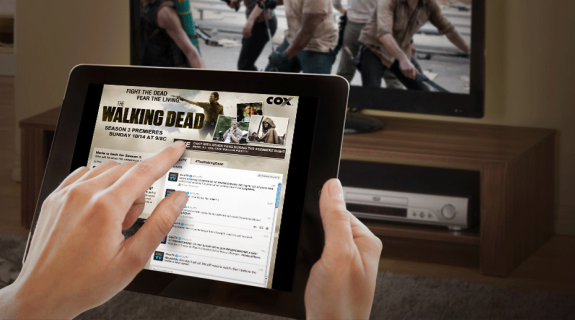TV and social media are steadily merging into a solid media platform, and the term “second screen” can now apply to the living room TV, smartphone, tablet or whichever is the screen in front of you. As the term “second screen” approaches overuse, marketers and producers begin to wonder: Which screen is the second screen?
The two entities continue to work together in a mutually beneficial relationship, but now TV brands need to look at finding the right second (or third or fourth) screen for them, and how much to give to the viewer, according to the “2nd Screen – Social Television” panel at Digital Hollywood in Los Angeles today.
One point up for contention was: which screen is the second screen – and which is the first? Panelists discussed a possible future where there is only one screen, with the content and all of its social activity existing in one place, but others balked at the idea.
“In many ways I think the second screen right now is your TV,” said Simon Kelly, CEO, North America/Asia of Story Worldwide. “The second screen can be any screen – it’s wherever you are. Ultimately it’s going to be one screen.”
According to Jim Cannella, director of marketing and strategic alliances, The Recording Academy (The GRAMMYs), broadcast TV isn’t heading to one screen but to unique personalized experiences for each viewer. “As the size of the screen shrinks, it becomes more and more personal to the user,” he said. “We haven’t seen a real penetration of smart TVs – consumers just aren’t buying them, because it’s too complicated to work your cable box, much less a fifth remote in the arsenal. Keep that experience with your handheld and tablet that people use all day.”
“I believe more and more that the smartphone in your pocket or your tablet will be what will control what you watch,” said Dean Alms, VP of product experience at Milyoni (pronounced “million-eye”).
Even more important, according to the panelists, is which screen is right for each viewer. Most agreed that it all comes down to letting the consumer decide – the best experience is one that works across platforms, letting the viewer choose for themselves not only where to engage with the content onscreen but also how.
“At the end of the day, the main screen really still is the television,” said Lisa Farris, founder and CEO of Get This. “The audience does not want you to touch that screen with interactivity, they want to control it.”
“It’s driven by the consumer, whether the consumer wants it on one screen or multiple screens,” said Channing Dawson, senior advisor at Scripps Networks Interactive. “Wherever we put that excess content, I’ll want to be able to move all of that content anywhere I want it.”
“That’s the future, working with content creators and seeing how authentically they can add to the story,” said Kelly.
Some folks using the second screen to their advantage, according to the panel? UFC, Red Bull, Al Jazeera, Syfy Sync, Heineken with soccer brands, ESPN, Bravo.
Tags:













































__twocolumncontent.jpg)











